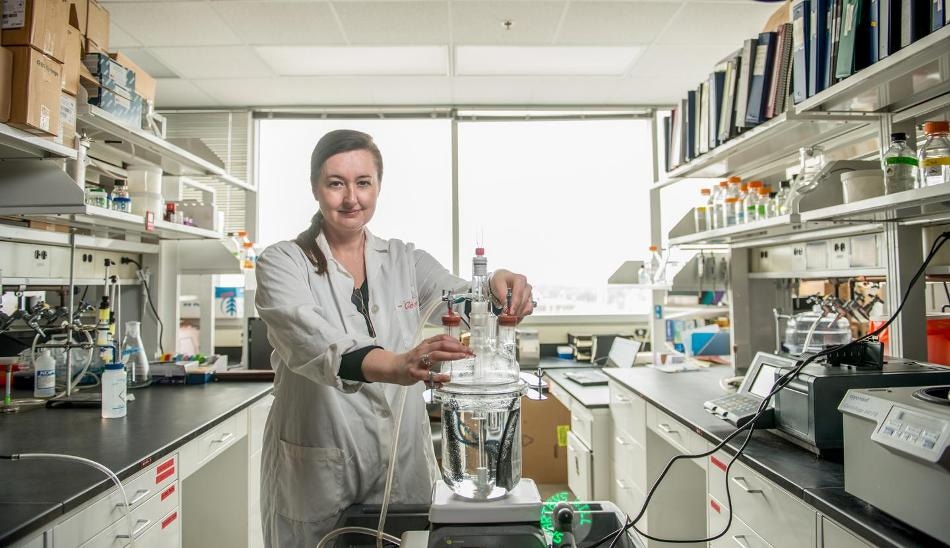Aug 3 2016
 Gemma Reguera's patented bioelectrodes have an electrifying taste for waste -- and they're ready to be scaled up. (CREDIT: Photo by Kurt Stepnitz)
Gemma Reguera's patented bioelectrodes have an electrifying taste for waste -- and they're ready to be scaled up. (CREDIT: Photo by Kurt Stepnitz)
Michigan State University (MSU) has conducted a research study that displays how Geobacter bacteria grow as films on electrodes to generate electricity. This process is now ready for industrial applications and has been featured in the recent issue of Nature Communications.
The thick biofilm, which is a gelatin microbial dynamo of sorts, is a mixture of cells loaded with cytochromes, metal-based proteins, and pili, which are hairlike protein filaments discovered and patented by Gemma Reguera, who is an associate professor of microbiology at MSU.
The biofilms can be compared to electrical grids. Each cell is a power plant that generates electrical discharges, delivered to the underlying electrode with the help of a network of pili and cytochromes.
The cytochromes are similar to the towers and transformers that supply electricity to the city. Although very sparse, pili can be considered as mighty powerlines which connect the towers to the grids, irrespective of the distance from the power plant.
Pili and cytochromes work together for shorter ranges (for around 10 layers of cells that are closest to the electrode). The efficiency of the cytochrome as an electron carrier decreases as more cells are piled on the electrode, after which the pili discharges the electrons at a rate 1,000 times faster than normal.
The pili do all of the work after the first 10 layers, and allow the cells to continue to grow on the electrode, sometimes beyond 200 cell layers, while generating electricity. This is the first study to show how electrons can travel such long distances across thick biofilms; the pili are truly like powerlines, at the nanoscale.
Gemma Reguera, Associate Professor, MSU
The transfer speed of cytochromes is lost once they move far away from the cell. She also explained that in the absence of wires, the biofilm will stop growing on the electrode.
The sequential procedure of analyzing the contribution and interactions amongst cytochromes and the pili stands as the main clue to this discovery. A genetic approach has been adopted by the researchers to eliminate the main electron carriers in the biofilms, conductive pili and cytochromes.
The researchers also studied the impact of mutations in the growth of the biofilm and also their ability to produce electricity. A mutant that could produce pili with reduced conductivity was also constructed by them.
"We used the mutants to grow biofilms of precise thickness and capacity to produce electricity," Reguera said. "This information allows us to reconstruct the paths - cytochromes or pili - used by the cells to discharge electrons across the biofilm and to the underlying electrode."
The ability of the biofilm to mechanistically stratify as its thickness increases on the electrode without harming the electricity generation was commendable.
We went from constructing the cell equivalent of a 10-story building to a 15- and a 20-story building and demonstrated the coordinated action of cytochromes and pili in the bottom floors and the need to discharge electrons via the wires in the upper floors to grid. We know that we can build 200-story buildings, which really opens up opportunities for which these biofilms can be used.
Gemma Reguera, Associate Professor, MSU
She also stated that microbes possess a taste for waste in their natural state. Reguera's bioelectrodes also have a huge appetite for waste, and can be easily used to cleanup industrial sites while simultaneously producing electricity as a byproduct. Exploring the potential company options that can introduce bioelectrodes to market will be the next phase of the project.
The National Science Foundation, an MTRAC grant supported by the State of Michigan 21st Century Jobs Funds (received through the Michigan Strategic Fund and administered by the Michigan Economic Development Corporation) and MSU AgBioResearch funded this research project.
Michigan State University 2011 President's Report: Zapping nuclear waste.
Video Credit: Michigan State University/Youtube.com